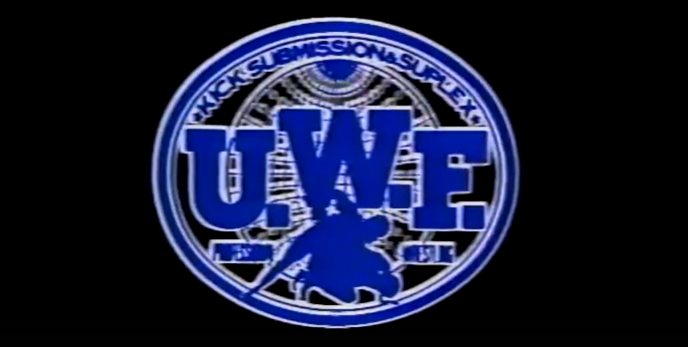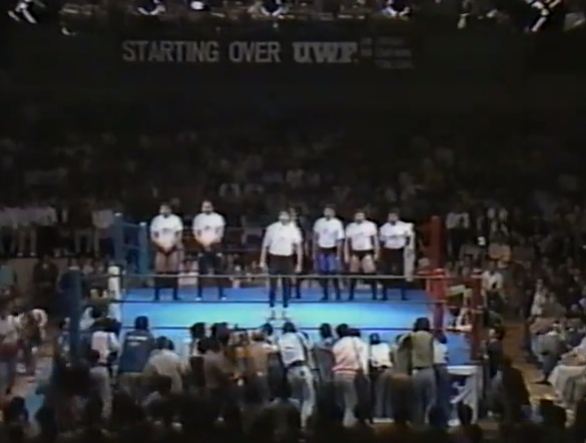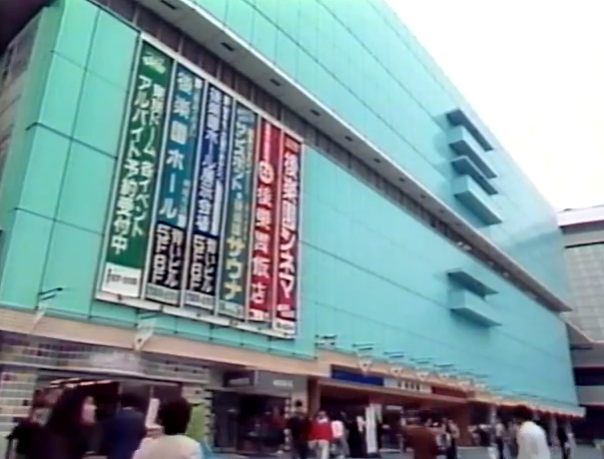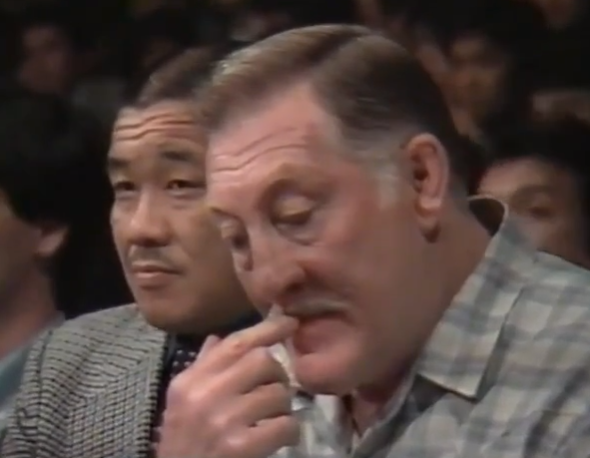UWF Starting Over (5.12.88) review
May 12, 1988
We’re in Tokyo, Japan at the world famous Korakuen Hall. 2,300 on hand for this first ever UWF event. Akira Maeda is a fascinating character study. He came through New Japan as a young boy and was clearly a talent but he was interested in a shoot-style of pro-wrestling. In 1984 he broke away from NJPW, in a time where that was a rarity, and formed UWF. His partnership with Satoru Sayama (aka Tiger Mask I) didn’t pan out and Sayama’s ego drove Maeda back into Antonio Inoki’s open arms. Maeda, in returning to NJPW, became one of its biggest stars.
Maeda, a ‘bad boy’ of pro-wrestling, had issues with Inoki too and refused to work a program with the big man. I can only guess he assumed Inoki would do what Inoki always did and book himself to win. Maeda had an infamous clash with Andre the Giant in 1986 where it turned into a shoot and the politics of pro-wrestling came gushing out of the locker room and into the public eye. In late 1987, Maeda delivered the (also) infamous shoot kick to Riki Choshu that broke his orbital bone. Maeda was suspended by New Japan, although he went on to claim the famous kick was an accident and Choshu was supposed to block it.
Maeda, clearly feeling wronged by NJPW, frustrated by Inoki’s bullshit and carving a niche for himself as a maverick shooter, decided to give UWF a second shot. This version of UWF, sometimes dubbed “Newborn UWF” was Maeda and fellow NJPW wrestler (and frequent tag partner) Nobuhiko Takada striking out on their own. Shoot style. Controversy. Falling out with bookers and partners. This is the Akira Maeda story.

KICK. SUBMISSION. SUPLEX.
He’s talking my language, baby.


I love that they’ve shot some stuff outside to hype this up. This is what Korakuen Hall looks like from the outside. It’s a big blue building, which looks like random office space. When you go inside, trying to find the ticket office is an experience.
Pre-show the ring announcer welcomes various stars of other promotions and other fighting styles. This includes Yoshiaki Fujiwara and Karl Gotch. The latter gets a recorded interview where he talks about shoot-style and how it could work out if they get good young Japanese talent and train them in that specific style.

Exhibition Match
Nobuhiko Takada vs. Shigeo Miyato
Miyato was trained by Maeda and has featured as an undercard guy on NJPW cards. At time of writing he’s head trainer of the UWF Snake Pit in Japan. The match feels completely different from minute one. They spar with kicks before Miyato takes it to the mat with a single leg. It has a ‘real fight’/sports feel that even normal Japanese strongstyle wrestling doesn’t come close to comparing to.
This is a ten-minute match regardless of what happens. This exposes the smaller Miyato somewhat as Takada spends most of that ten minutes abusing him. It is weird seeing stuff being so cooperatively non-cooperative. Like a judo throw is blocked by Takada widening his stance and shifting his weight.
Takada gets a submission after 6:00 with a leglock, itself a counter to another leglock from Miyato. The torture continues with an armbar and Miyato taps out again. Now it’s all about pride from Miyato, trying to avoid another submission. In the process he gets the absolute tar kicked out of him. It’s so stiff.
The whole thing feels like a message to Sayama as Miyato is of similar height and style. His kicking got nowhere while Takada ruthlessly picked him apart. Also, the rules of the match mean despite being beaten comfortably, the result is always going to be a draw. It feels like in booking this Maeda was taking heavy shots at Satoru Sayama.
Anyhow, it’s a great exhibition match and a fine display of Takada’s strengths. He’s the guy Maeda is telling you to worry about here. If there’s a claimant to Maeda’s spot as top guy, it’s not Sayama. It was never Sayama. It’s his mate Takada. Until they fell out a few years later. Hey, it happens. ***
As I’m watching this, it occurs to me that Inoki’s obsession with getting his boys shoot matches probably stemmed from Maeda’s antics. Not only did he want his wrestlers to be able to protect themselves but also have more legitimacy than Maeda’s clan. Maeda, for all his bluster, had not been involved in shootfighting before developing his shootstyle. It’s also funny to me that Maeda turned his promotion into an MMA promotion AFTER he retired. How convenient eh?
Yoji Anjo vs. Tatsuo Nakano
Anjo was part of the original UWF in 1985. With a shoot background in judo, he was recruited by Takada. Nakano is slightly his superior, having debuted a year earlier. They regularly teamed up in NJPW and fought each other too. Anjo hasn’t yet become ‘eccentric’ and his gimmick is just ‘shooter’ like everyone else in the promotion.
This is a more competitive match than the opener, but it lacks the excitement of it. There’s a lot of slower work, trying to position the opponent for holds and this style hasn’t quite gotten enough of a blueprint for them to feed off. Remember, this is years before UFC. It is fascinating to watch such an early form of the style. The main difference between shootstyle and strongstyle is that strikes in shootstyle are designed to weaken, rather than show strength, and are more effective when connecting to valuable body parts.
As much as I love a good strike duel, it is nonsense. This match is more grappling based. Nakano is deliberate, bordering on sluggish, while Anjo is the more exciting of the two. As I type that Nakano busts out the dragon screw leg whip, right into a leglock. It’s interesting to note there’s no pinfalls here and Anjo forgets that. He gets this little flipping pin, and the ref just looks at him. Submission or knock out*!
*I’m still not 100% sure about this after the main event. Keep reading.
Anjo looks like he’s about to go for another pin but remembers the rules this time and switches to an armbar. Anjo controls big chunks of this match and Nakano has to resort to taking chances when they appear. Like when Anjo swats at him and Nakano is able to duck under into a sleeper.
It’s nice to see a sleeper hold where you can see the mechanics of a guy wrestling his way out of it rather than a pre-planned counter or just Hulking up. Anjo’s thought processes and skill are shown here. It’s a precursor to modern MMA. Nakano lacks the skill to lock that sleeper in and win by choking Anjo out. Anjo is skilled enough to escape.
Nakano also falls foul of the pinfall situation by attempting a German suplex and Anjo counters out by grabbing his already weakened arm. All in all, they do a good job of explaining the rules of UWF in this match. To make it clearly obvious what you can and cannot do. Maeda has booked smartly again here, designing this as a ‘rules exhibition’ so people are more into his match.
I’m a little surprised by the finish where Anjo, who bossed big chunks of the match chases a finish and gets caught with an armbar submission out of nowhere. Again, this is them trying to tell a story about the rules and how finishes can be built to or, like a real fight, come out of nowhere. ***½
Akira Maeda vs. Kazuo Yamazaki
For his first match, Maeda has recruited Yamazaki. Like the others he was also in the original UWF but unlike the others, he was a Sayama guy. He was trained by Sayama and Fujiwara. He was also in NJPW before UWF unlike the last two guys. It gives us a little more history with Maeda selecting someone who’s clearly a protégé of two other noted shooters but specifically Sayama.
Yamazaki was a top talent in the original UWF, and I watched, but didn’t review, a match between him and Takada, which is arguably the best match the original UWF produced. An issue faced by UWF here is that they’ve only got three matches, due to a lack of workers, but that means the matches have to go long. You can’t put on three ten-minute bouts and be done in under an hour. So, as with the last match, this is tentative and slow to start with.
Yamazaki, perhaps predictably after training under Fujiwara, goes for armbars. Maeda heavily outweighs him though, which makes it hard to get his weight on top of Maeda and force a submission. In a shoot, size is everything. Which is why there are weight divisions in MMA and boxing. This is also heavily implied as Yamazaki tries to strike with Maeda and gets caught in a huge capture suplex going for a high kick.
Yamazaki is fantastic here though. He’s so tenacious. He won’t give up. He fights to get out of everything. He doesn’t take any of Maeda’s shit. Maeda then confuses me by going after a pin and the ref counts it. I thought there were no pins in this company? Is he making it up as he goes along?
Yamazaki lands one of those Sayama-esque spin kicks and the crowd loves that. The general performance from Yamazaki is fighting from underneath and it’s a cracking performance. Maeda starts playing with his food a bit around 15 minutes in. Half-heartedly kicking at Yamazaki. Maeda gets pinned and the ref doesn’t even drop to start to count it. What the fuck?
In response Yamazaki fucking DECKS Maeda with two huge high kicks. It gives the crowd belief that Yamazaki can win if he catches Maeda right and knocks his big ass out cold. Maeda does a good job of showing how groggy he is and Yamazaki kicks his head off. The crowd get all fired up and try to count Maeda out of his own main event. Maeda just about recovers, clocks Yamazaki with a roundhouse and taps him out with a katahajime. ****
This got really good down the stretch with Yamazaki having to go big or go home. In the end he didn’t quite have enough big hits in his repertoire to down the star of the show. Maeda’s win feels inevitable and him being helped out of the ring shows what a fantastic upstart performance it was from Yamazaki. The crowd rises to chant “MA-EDA” as we go off the air, happy with the first show from the new promotion.
The 411:
In terms of setting out your stall, this is a great start for UWF. They showcased their stars, showcased their style and showcased what the UWF could be. It needed more excitement outside of the main event. Takada’s match was just him beating someone up. There was no challenge there at all. Maeda-Yamazaki was really good though and it’s an easy thumbs up for their first show. It helps that it caters to a style I am very much in love with.
 Twitter
Twitter